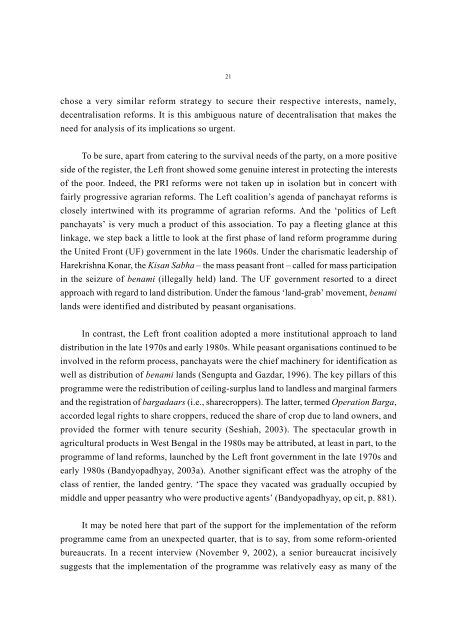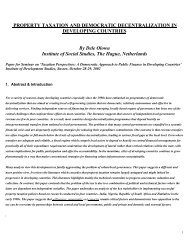View Article - Institute of Development Studies
View Article - Institute of Development Studies
View Article - Institute of Development Studies
You also want an ePaper? Increase the reach of your titles
YUMPU automatically turns print PDFs into web optimized ePapers that Google loves.
21chose a very similar reform strategy to secure their respective interests, namely,decentralisation reforms. It is this ambiguous nature <strong>of</strong> decentralisation that makes theneed for analysis <strong>of</strong> its implications so urgent.To be sure, apart from catering to the survival needs <strong>of</strong> the party, on a more positiveside <strong>of</strong> the register, the Left front showed some genuine interest in protecting the interests<strong>of</strong> the poor. Indeed, the PRI reforms were not taken up in isolation but in concert withfairly progressive agrarian reforms. The Left coalition’s agenda <strong>of</strong> panchayat reforms isclosely intertwined with its programme <strong>of</strong> agrarian reforms. And the ‘politics <strong>of</strong> Leftpanchayats’ is very much a product <strong>of</strong> this association. To pay a fleeting glance at thislinkage, we step back a little to look at the first phase <strong>of</strong> land reform programme duringthe United Front (UF) government in the late 1960s. Under the charismatic leadership <strong>of</strong>Harekrishna Konar, the Kisan Sabha – the mass peasant front – called for mass participationin the seizure <strong>of</strong> benami (illegally held) land. The UF government resorted to a directapproach with regard to land distribution. Under the famous ‘land-grab’ movement, benamilands were identified and distributed by peasant organisations.In contrast, the Left front coalition adopted a more institutional approach to landdistribution in the late 1970s and early 1980s. While peasant organisations continued to beinvolved in the reform process, panchayats were the chief machinery for identification aswell as distribution <strong>of</strong> benami lands (Sengupta and Gazdar, 1996). The key pillars <strong>of</strong> thisprogramme were the redistribution <strong>of</strong> ceiling-surplus land to landless and marginal farmersand the registration <strong>of</strong> bargadaars (i.e., sharecroppers). The latter, termed Operation Barga,accorded legal rights to share croppers, reduced the share <strong>of</strong> crop due to land owners, andprovided the former with tenure security (Seshiah, 2003). The spectacular growth inagricultural products in West Bengal in the 1980s may be attributed, at least in part, to theprogramme <strong>of</strong> land reforms, launched by the Left front government in the late 1970s andearly 1980s (Bandyopadhyay, 2003a). Another significant effect was the atrophy <strong>of</strong> theclass <strong>of</strong> rentier, the landed gentry. ‘The space they vacated was gradually occupied bymiddle and upper peasantry who were productive agents’ (Bandyopadhyay, op cit, p. 881).It may be noted here that part <strong>of</strong> the support for the implementation <strong>of</strong> the reformprogramme came from an unexpected quarter, that is to say, from some reform-orientedbureaucrats. In a recent interview (November 9, 2002), a senior bureaucrat incisivelysuggests that the implementation <strong>of</strong> the programme was relatively easy as many <strong>of</strong> the





